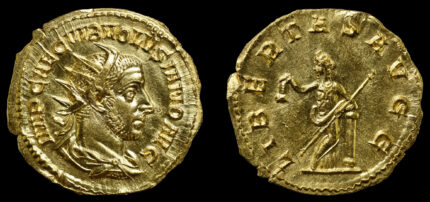An extremely rare gold double-aureus from the reign of the Emperor Volusianus has been discovered in Hungary. Volusianus ruled as co-emperor with his father Trebonianus Gallus for less than two years (November 251 – August 253) before they were both assassinated by their own soldiers, so coins from his reign are already rare. Gold Volusianus coins are even more rare, with the rarest of all being the binio, double the weight and value of a standard aureus.
Minted in Rome, the coin weighs 5.62 grams and is 23 mm (.9 inches) in diameter. It features a draped and cuirassed bust of the emperor wearing a radiate crown on the obverse. The obverse legend reads IMP CAE C VIB VOLVSIANO AVG (Imperator Caesar Caius Vibius Volusianus Augustus). On the reverse is the deity Libertas standing with one bent leg in front the other leaning on a column. She wears a draped garment and holds a pileus (the freedman’s cap) in her right hand and a long scepter in her left. The reverse legend reads LIBERTAS AVGG, meaning Liberty of/as brought by the two emperors.
The coin was discovered by a volunteer metal detectorist working for the Rippl-Rónai Museum in an archaeological investigation at the site of highway expansion in Somogy County, southwestern Hungary. The excavation yielded bronze and silver coins, a round glass fibula with a checkerboard pattern, an inscribed silver ring and a bronze key.
Few Roman gold coins have been unearthed in Hungary, which was part of the province of Pannonia Superior when this binio was minted. The capital of the province was in Carnutum, now part of Austria, 200 miles northwest of the coin’s find site. Today Somogy County is the least densely populated county in Hungary, and it was even more remote in the 3rd century. Only one other Roman gold coin, minted under the Emperor Valens (r. 364-378), has been found in the county. An extremely valuable and rare coin like a double-aureus wasn’t likely to be owned by a local. It was probably lost by someone moving through the area.
The coin is now at the Rippl-Rónai Museum where it will be assayed to determine its gold content. It will then join the museum’s permanent collection of around 50 Roman coins, including the only other gold coin found in Somogy.